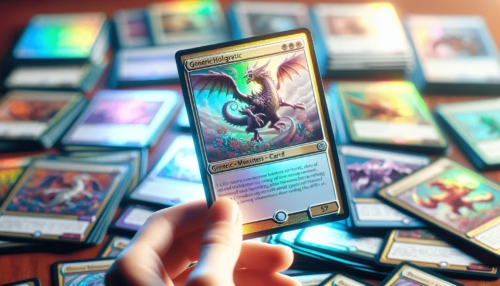Are you curious about how a seemingly simple hobby, such as collecting Pokémon cards, can evolve into a lucrative investment strategy? This question touches on a dynamic market that’s captured not just the passion of collectors but the attention of investors worldwide. Pokémon cards have transcended their humble origins as a child’s pastime to become a multifaceted market, intertwining nostalgia with financial strategy.
In this advanced guide, we examine the intricacies of Pokémon card collection and investment strategies—delving into its history, current market trends, and future implications. For anyone considering the potential of Pokémon cards, understanding these aspects can provide both enjoyment and financial benefit.

Table of Contents
Historical Context of Pokémon Cards
The phenomenon of Pokémon cards began in 1996 in Japan as part of the broader Pokémon franchise created by Satoshi Tajiri and Ken Sugimori. The game’s initial purpose was straightforward: entertainment through card battles. Over the years, however, it has expanded dramatically in scope and value. The cards became collectible, not only for their gameplay utility but as artifacts of pop culture. By the late 1990s and early 2000s, Pokémon had reached global acclaim, with cards becoming sought-after items.
The key turning point for Pokémon cards as an investment opportunity occurred when rarity and condition began to be intrinsically linked to value. Cards from earlier sets, especially those featuring iconic characters like Charizard, became highly coveted. The first edition base set in particular skyrocketed in worth, primarily due to limited print runs and the franchise’s burgeoning popularity.
Current Trends in Pokémon Card Collecting
In recent years, Pokémon cards have surged in popularity again, spurred by social media, high-profile auctions, and nostalgia for the 90s era. Limited print runs, special edition releases, and collaborations have driven demand, creating a dynamic market ripe with investment potential.
The Influence of Celebrity Endorsements
Celebrity endorsements have significantly impacted the Pokémon card market. YouTube influencers and celebrities like Logan Paul have spotlighted rare cards in high-profile videos, fueling public interest and escalating prices. This phenomenon underscores a broader trend where pop culture figures can sway market dynamics and elevates the profile of collectibles to much wider audiences.
Increasingly Competitive Market
The increase in collectors’ interest has also led to a competitive market environment. With entries of professional graders like PSA (Professional Sports Authenticator) and BGS (Beckett Grading Services), the differentiation in card value based on condition has become more pronounced. These grading companies assess cards for authenticity and condition, providing a standardized rating that significantly influences market prices.
Key Concepts and Definitions
Understanding Rarity and Scarcity
In the context of Pokémon cards, rarity and scarcity are distinct yet interrelated concepts. Rarity refers to how uncommon a card was at the time of its release. Scarcity pertains to how few cards are available in the market today—often due to cards’ being lost, damaged, or simply held long-term by collectors.
Grading and Its Impact
Grading is vital in determining a Pokémon card’s market value. A graded card receives a score based on factors such as corner wear, surface condition, centering, and edges. Scores can significantly affect the card’s investment potential, with higher grades fetching premium prices. Investors often seek to acquire cards in mint condition or higher to maximize value.
Investment Strategies in Pokémon Cards
Diversifying Your Collection
One cornerstone of investment strategy is diversification, which applies to Pokémon cards as well. By diversifying the portfolio with different cards—spanning various series, rarity levels, and conditions—investors can mitigate risks associated with market fluctuations.
Long-term vs. Short-term Investment
The choice between long-term and short-term investment strategies is crucial. Long-term investors focus on holding rare and valuable cards, banking on long-term appreciation. Short-term investors may exploit market trends, flipping cards quickly for profit. Each strategy requires distinct knowledge and expertise to execute effectively.
Case Study: The Illustration Charizard
One prominent case epitomizing investment success in Pokémon cards is the Illustration Charizard from the Base Set. The card’s value amplified substantially due to limited availability, cultural significance, and condition. It became a hallmark card within the collecting community, often fetching several hundred thousand dollars at auction. The enduring allure of such a card exemplifies how nostalgia and rarity converge, driving market dynamics.

Comparison with Other Collectible Markets
Pokémon Cards vs. Baseball Cards
Much like Pokémon cards, baseball cards have been a staple in the collectible market, offering comparative insights. Both markets thrive on rarity, condition, and nostalgia, yet they differ in demographic reach and historical background. The Pokémon card market tends to involve a younger demographic and rapid digital engagement, whereas baseball cards often resonate with traditional sports enthusiasts.
Pokémon Cards vs. Comic Books
Comic books share many parallels with Pokémon cards—both born from popular culture and possessing passionate fan bases. However, the narratives provided by comic books differ, offering storytelling alongside collectible value. The cross-promotion and transmedia storytelling of comic book characters (e.g., film adaptations) can elevate value, much like blockbuster Pokémon media releases impact card desirability.
Impact Assessment of Collectible Investment
Understanding the impact of investing in Pokémon cards extends beyond potential financial gain. The hobby fosters community connections and preserves cultural heritage. The rise of online marketplaces and social media platforms has democratized access to information and market participation, enabling collectors and investors to connect globally.
Additionally, the environmental and ethical aspects of collectible production are becoming increasingly important. As demand grows, manufacturers and investors alike must consider sustainability and responsible sourcing practices.

Predictions and Future Directions
Digital Integration in Collectibles
The future of Pokémon card investment will likely intertwine with digital innovation. Augmented Reality (AR) and Non-Fungible Tokens (NFTs) may enhance how collectors engage with their collections, creating new experiential and transactional avenues. Digital platforms will also facilitate seamless trading, broadening the market’s accessibility.
Sustainable Collecting
As awareness of environmental issues increases, sustainable practices in card production and packaging will become more significant. Companies responding to consumer demand for eco-friendly products may shape brand loyalty and future market trends.
Conclusion
In summary, the Pokémon card market offers a fascinating blend of collecting and investing. It encapsulates nostalgia, rarity, and strategic financial growth. As the market evolves, staying informed and adaptive will be paramount for potential investors. What are your thoughts on the potential of integrating new technologies like NFTs into the Pokémon card market, and do you see them as a complement to or detraction from traditional collecting? Inquiry into these prospects can yield valuable insights into future market directions.
Finally, dive deeper into related topics such as NFT integration in collectibles or explore strategies in other collectible markets to gain insights that could enhance your investment journey.

The Ultimate Guide to Investing in Pokémon Cards: Maximizing Returns

